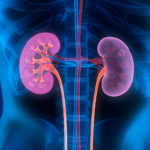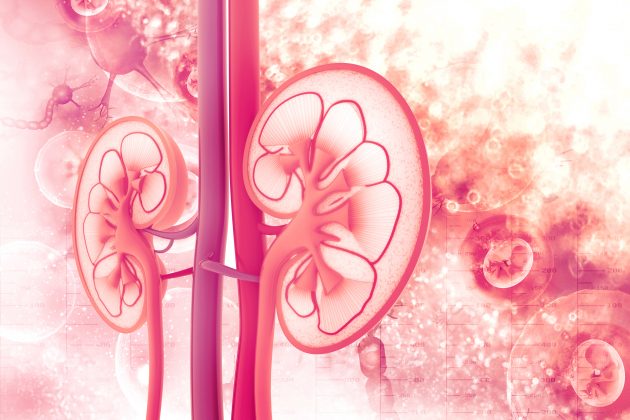
In the general population in the United States, the leading cause of death is cardiovascular disease, accounting for nearly 25% of deaths. Among patients with end-stage kidney disease (ESKD), the prevalence of cardiovascular disease is approximately 10 to 20 times that in the general population. However, there are few data available regarding a consensus on estimating future cardiovascular risk in patients with ESKD.
There is an increase in the use of cardiac biomarkers to predict cardiovascular morbidity and mortality in asymptomatic patients. The biomarkers brain natriuretic peptide (BNP) and the inactive cleavage fragment N-terminal pro-BNP (NT-proBNP) are released upon ventricular stretch or ischemia, and have been shown to be associated with death in patients with heart failure, stable and active coronary artery disease, sepsis, and in high-risk non-cardiac surgery patients.
Kidney function has been shown to have an inverse correlation with peptide concentrations. Recent studies have suggested significant associations between elevated baseline NT-proBNP and BNP levels and cardiovascular morbidity and mortality in patients with ESKD. However, according to Tyrone G. Harrison, MD, and colleagues the utility of the biomarkers in patients with ESKD has been limited by heterogeneous relationships between biomarker level elevations and outcomes. The researchers conducted a systematic review and meta-analysis to examine associations between different threshold elevations of NT-proBNP and BNP and clinical outcomes in patients with ESKD. Results of the review were reported in the American Journal of Kidney Diseases [2020;76(2):233-247].
The search included MEDLINE via Ovid (1946 to September 10, 2019) and EMBASE (1974 to September 10, 2019), using medical subject headings and text words with analogous terms for end-stage kidney disease, renal replacement therapy, brain natriuretic peptide, and N terminal pro-brain natriuretic peptide. The search was limited to observational studies and observational analyses of trials without restriction on intervention type or language. Studies of pediatric patients, transplant recipients, pregnant patients, and those with acute kidney injury were excluded. The EMBASE search also included relevant conference abstracts from the past 5 years.
Of the 4960 nonduplicate studies identified, 4734 were excluded at title and abstract level. A total of 226 studies underwent full-text review. Of those, 61 were included in the systematic review, and 49 in the meta-analysis.
The 61 studies were published from 2001 to 2019; 18 examined BNP, 40 examined NT-proBNP, and three investigated both. The type of peptide assays varied and most BNP assays were completed with frozen samples. Study size ranged from 44 to 2990 patients, for a total of 19,688 patients. The study cohorts were predominantly men and average age was 46.0 to 75.4 years. Forty-four of the studies included only patients receiving hemodialysis; 10 included only patients receiving peritoneal dialysis, five included patients receiving either hemodialysis or peritoneal dialysis, and one included patients with kidney failure without kidney replacement therapy. Time on maintenance dialysis therapy ranged on average from 0.25 to 9.4 years and study follow-up ranged on average from 0.9 to 8 years. When reported, baseline prevalence of cardiovascular disease, diabetes, and hypertension ranged from 7% to 100%, 0% to 100%, and 22% to 96%, respectively.
Quality of the studies was assessed using the Newcastle Ottawa Scale, designed for nonrandomized studies. Quality assessment also utilized the Outcome Reporting Bias in Trials II (ORBIT II) tool by applying it to the exposure groups in the observation studies in place of interventions from trials. The ORBIT II tool assesses the risk for outcome reporting bias, characterized as high/low/none for each outcome.
The Newcastle Ottawa Scale includes a total of nine potential points. Of the 61 studies included in the review, 87% (n=53) received seven or more points (high quality); the median score was eight (interquartile range, 7-9). Most of the studies (79%, n=48) included adjusted estimates. Risk for outcome reporting bias was identified as being generally low for the cardiovascular events (high risk in 6 studies), but high for the cardiovascular mortality outcome (high risk in 35 studies).
Of the 61 studies, 31 (51%) provided data for cardiovascular mortality, with a total of 1533 events (range of 4-238 cardiovascular deaths per study). Twenty-one studies examined the relationship between NT-proBNP and CV mortality. Nine provided unadjusted effect estimates, and nine provided adjusted effect estimates to enable meta-analysis. Threshold-specific unadjusted hazard ratios (HRs) were progressively greater with greater level of NT-proBNP threshold: from 1.45 (95% confidence interval [CI], 0.91-2.32) at level >2000 pg/mL to 5.95 (95% CI, 4.23-8.37) at >15,000 pg/mL. BNP levels >550 pg/mL were associated with increased risk for cardiovascular mortality (HR, 2.54; 95% CI, 1.49-4.33).
Data for all-cause mortality were reported by 56 studies (91.8%), for a total of 4712 events (range, 9-612 deaths per study). The risk for all-cause mortality were significantly higher at all NT-proBNP thresholds, ranging from >1000 to <2000 pg/mL (HR range, 1.53-4.00). The risks for all-cause mortality at BNP levels >100 pg/mL were 2.04 and 2.07 at BNP levels >550 pg/mL.
Results of adjusted analyses demonstrated similarly greater risks for both cardiovascular and all-cause mortality with greater NT-proBNP concentrations.
Limitations to the findings cited by the authors included incomplete reporting of outcomes and the possibility of outcome reporting bias, and poor precision in estimations of the risk for cardiovascular events for specific thresholds of both peptides.
“These limitations notwithstanding, our study provides new and potentially clinically useful information on the relationships of various thresholds of NT-proBNP and BNP levels with outcomes in patients with ESKD including increased risk for cardiovascular mortality, all-cause mortality, and cardiovascular events. Further work is warranted to identify how to incorporate the use of natriuretic peptides to stratify and reduce cardiovascular risk for patients with ESKD,” the researchers said.
Takeaway Points
- In a systematic review and meta-analysis, researchers examined associations between various thresholds of the brain natriuretic peptide (BNP) and N-terminal pro-BNP (NT-proBNP) and clinical outcomes in patients with end-stage kidney disease (ESKD).
- Pooled unadjusted hazard ratios for cardiovascular mortality were progressively greater for greater thresholds of NT-proBNP; the risk for all-cause mortality was also significantly higher at all NT-proBNP thresholds.
- There was an increased risk for cardiovascular mortality with BNP levels >550 pg/mL; the risk for all-cause mortality was 2.07 at BNP levels >550 pg/mL.
Credit: Original article published here.









